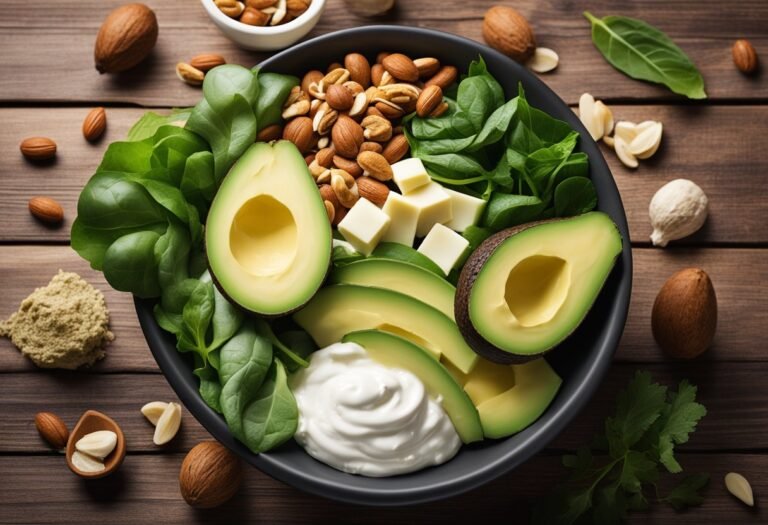Keto Diet for Lipedema: A Comprehensive Guide to Managing Symptoms and Health
Managing lipedema can be challenging, especially when it comes to controlling weight and inflammation. The ketogenic diet offers a potential approach to help reduce symptoms and improve overall well-being for those affected by this condition. By focusing on low-carb and high-fat nutrition, many individuals have found relief from the discomfort associated with lipedema.

As you explore the connection between the keto diet and lipedema, you might discover how specific dietary choices can influence your body’s response to the condition. Those who have adopted this eating plan often report positive changes in their symptoms and a better quality of life. With the right information and strategies, you can implement the keto diet effectively and navigate the challenges it may bring.
If you’re looking to enhance your understanding and potentially find relief through dietary changes, this article will cover essential aspects of the keto diet and its impact on lipedema. You’ll learn practical tips for starting and maintaining this diet to support your health journey.
Key Takeaways
- The keto diet may help manage symptoms of lipedema.
- Knowing how to effectively implement the keto diet is crucial for success.
- Be aware of potential challenges when adopting a new eating plan.
Understanding Lipedema

Lipedema is a chronic condition that primarily affects women. It involves an abnormal accumulation of fat, often leading to physical discomfort and emotional challenges. Gaining a clearer understanding of its definition, symptoms, and diagnostic process is essential for managing this condition.
Definition and Symptoms
Lipedema is characterized by a disproportionate buildup of fat in specific areas of the body. This typically occurs around the hips, thighs, and lower legs, while the feet often remain unaffected. The condition is often mistaken for obesity or lymphedema but differs significantly in its characteristics.
Common symptoms include:
- Swelling: Areas affected by lipedema may swell, particularly after prolonged standing or sitting.
- Pain and tenderness: You might experience sensitivity and discomfort, making everyday activities challenging.
- Easy bruising: Many women with lipedema notice they bruise easily, even with minor impacts.
Recognizing these symptoms early is important for effective management and treatment.
Diagnosis of Lipedema
Diagnosing lipedema can often be complex. Unlike other conditions, there is no specific test for lipedema. Instead, healthcare providers rely on a combination of medical history and physical examination.
Here’s how the diagnosis typically proceeds:
- Visual assessment: A doctor assesses the distribution of fat and any associated symptoms.
- Patient history: Discussing your symptoms, family history, and any previous weight changes is crucial.
- Exclusion of other conditions: Tests might be conducted to rule out lymphedema or other medical issues.
Early diagnosis can lead to better outcomes and tailored treatment options that align with your health needs.
Principles of the Keto Diet

The keto diet focuses on changing how your body gets energy. This is done by shifting to a low-carb, high-fat diet that induces ketosis. Understanding how ketosis works and the proper macronutrient ratios can improve your results with this approach.
Ketosis Explained
Ketosis is a metabolic state where your body burns fat for fuel instead of carbohydrates. When you significantly reduce your carb intake, your body has less glucose available for energy. To compensate, it begins to break down fat into molecules called ketones, which can be used as an energy source.
Achieving ketosis typically involves keeping your carbohydrate intake between 20 to 50 grams per day. This restriction forces your body to dip into its fat stores. It’s essential to monitor your carb intake carefully, as exceeding your limit can delay or prevent ketosis.
Macronutrient Ratios
For the keto diet to be effective, you need to follow specific macronutrient ratios. A common guideline is:
- Fat: 70-75% of your daily calories
- Protein: 20-25% of your daily calories
- Carbohydrates: 5-10% of your daily calories
These ratios help ensure you are in ketosis. Prioritizing healthy fats, such as avocados, nuts, and olive oil, while choosing quality proteins like fish and poultry is critical. Limit carbs mainly to non-starchy vegetables. Monitoring these ratios will help you optimize your diet for the best results.
Benefits of Keto Diet for Lipedema
The ketogenic diet has gained attention for its potential benefits in managing lipedema. This diet may help with weight management, reduce inflammation, and alleviate pain associated with the condition.
Weight Management
One of the significant benefits of the ketogenic diet is its impact on weight management. When you follow a low-carbohydrate, high-fat diet, your body enters a state called ketosis. In this state, your body burns fat for energy instead of carbohydrates.
This shift can lead to weight loss, which is crucial for individuals with lipedema. Reducing excess weight can help lessen the pressure on your joints and improve mobility.
Additionally, a ketogenic diet may help regulate your appetite through hormone modulation. Balanced insulin levels can result in fewer cravings, making it easier for you to stick to your dietary goals.
Inflammation Reduction
Lipedema is often characterized by inflammation and swelling. A ketogenic diet may help reduce this inflammation. Foods in a keto diet are typically low in processed sugars and refined carbohydrates.
These elements can contribute to inflammatory responses in the body. By eliminating them, you may notice a reduction in inflammation levels.
Furthermore, the high-fat content in a ketogenic diet includes healthy fats such as omega-3 fatty acids. These fats have been shown to possess anti-inflammatory properties. Incorporating foods like avocados and fatty fish can support your body in managing inflammation more effectively.
Pain Alleviation
Many individuals with lipedema experience pain due to fat accumulation and inflammation. The ketogenic diet may provide notable pain alleviation.
Research indicates that the diet can help lower the body’s inflammatory markers. Reducing inflammation can directly lead to less pain and discomfort.
Additionally, weight loss achieved through the ketogenic diet may relieve pressure on your joints and tissues. This reduction in pressure can further minimize pain.
Overall, adopting a ketogenic diet may help you experience a better quality of life by managing pain related to lipedema.
Implementing the Keto Diet
When you decide to implement the keto diet, careful planning and adherence are crucial for success. Focus on meal preparation, choosing the right foods, and transitioning smoothly to maintain your commitment to the diet.
Meal Planning and Prep
Start by creating a detailed meal plan for the week. This helps you stay organized and ensures you have keto-friendly options readily available. Aim to include three meals and two snacks daily.
Make a shopping list based on your meal plan. Consider batch-cooking items like casseroles, soups, or salads. These can save time and prevent you from straying from your diet. Use separate containers for portion control, as this keeps your meals organized and convenient.
Keto-Friendly Foods
Your food choices are essential for success on the keto diet. Focus on high-fat, low-carb foods. Key items to include are:
- Healthy fats: Olive oil, avocado, coconut oil, nuts, and seeds.
- Proteins: Fish, poultry, eggs, and lean cuts of meat.
- Low-carb vegetables: Leafy greens, broccoli, cauliflower, and zucchini.
Avoid foods high in carbohydrates such as grains, sugars, and starchy vegetables. Read labels carefully to ensure you select products that fit your dietary needs.
Transitioning and Adherence
Transitioning to the keto diet can be challenging. You may experience symptoms like fatigue and headaches, known as the “keto flu.” To ease this process, gradually reduce your carbohydrate intake over a few days rather than cutting carbs abruptly.
Staying committed is vital. You can use methods like meal prepping and keeping a food journal to track your progress. Additionally, consider joining a support group or finding a buddy who shares similar goals. This can provide motivation and accountability on your keto journey.
Potential Challenges and Considerations
Adopting a ketogenic diet for lipedema can bring benefits, but it also poses specific challenges. Understanding these potential issues is crucial for your success and overall health.
Common Side Effects
When starting a ketogenic diet, you may experience several side effects, often referred to as the “keto flu.” This can include fatigue, headaches, dizziness, and irritability. These symptoms typically occur as your body adjusts to burning fat instead of carbohydrates.
To ease this transition, consider staying well-hydrated and ensuring adequate electrolyte intake. Foods rich in potassium, magnesium, and sodium can help. Monitor your body’s response closely and consult a healthcare professional if symptoms persist or worsen.
Nutritional Deficiencies
Restricting carbohydrates may lead to nutritional deficiencies if you’re not careful about your food choices. Common vitamins and minerals that may be lacking include vitamin C, B vitamins, and fiber. This can impact your immune function, energy levels, and digestive health.
To mitigate risks, focus on nutrient-dense foods within the keto framework. Incorporate a variety of low-carb vegetables, nuts, and seeds. A multivitamin may also be beneficial, but it’s best to discuss this with a healthcare provider to ensure it meets your specific needs.
Long-Term Sustainability
Maintaining a ketogenic diet long-term can be challenging. Many find it hard to stick to the strict limits on carbohydrates, leading to potential weight regain or dietary fatigue. Social situations and food availability can also pose barriers.
Consider alternating between ketogenic and low-carb diets to make it more sustainable. This approach can provide flexibility while still helping manage lipedema symptoms. Also, developing meal plans and involving family or friends can help you remain committed and make the diet more enjoyable.
FAQS About Keto Diet for Lipedema
This section addresses common questions about the ketogenic diet and its impact on lipedema. You will find specific insights into benefits, dietary guidelines, and success stories.
What are the potential benefits of a ketogenic diet on lipedema symptoms?
A ketogenic diet may help reduce inflammation, which is often associated with lipedema. It can also aid in weight loss, helping to relieve some of the pressure on affected areas. Additionally, some individuals report decreased pain and improved overall quality of life when following this diet.
Can a ketogenic diet reduce the progression of lipedema?
While research is ongoing, some evidence suggests that a ketogenic diet may slow the progression of lipedema. The diet focuses on reducing carbohydrate intake, which can help control blood sugar levels and, in turn, may lessen the severity of symptoms related to the condition.
What is the efficacy of the ketogenic diet compared to the Mediterranean diet for lipedema management?
Studies comparing the ketogenic diet with the Mediterranean diet for lipedema management show varied results. The ketogenic diet may provide quicker weight loss and improved metabolic markers while the Mediterranean diet is known for its heart health benefits. Individual responses can differ, so it is important to assess which may work better for you.
What are the success stories associated with following a ketogenic diet for lipedema?
Many individuals with lipedema have shared personal success stories about their experiences with the ketogenic diet. Some have reported losing significant weight and experiencing reduced pain levels. These stories can provide hope and motivation for others considering this dietary approach.
Are there any specific dietary plans or guidelines available for managing lipedema with a ketogenic diet?
Yes, many resources provide specific dietary plans for managing lipedema with a ketogenic diet. Typically, these plans include low-carb options and emphasize high-quality fats and proteins. Working with a healthcare provider can help you tailor a plan to suit your needs.
What foods should be avoided to prevent exacerbation of lipedema symptoms?
To manage lipedema symptoms, you should avoid foods high in refined sugars and carbohydrates. Processed foods, trans fats, and excessive sodium can also worsen symptoms. Focusing on whole, unprocessed foods can be more beneficial for managing your condition.






